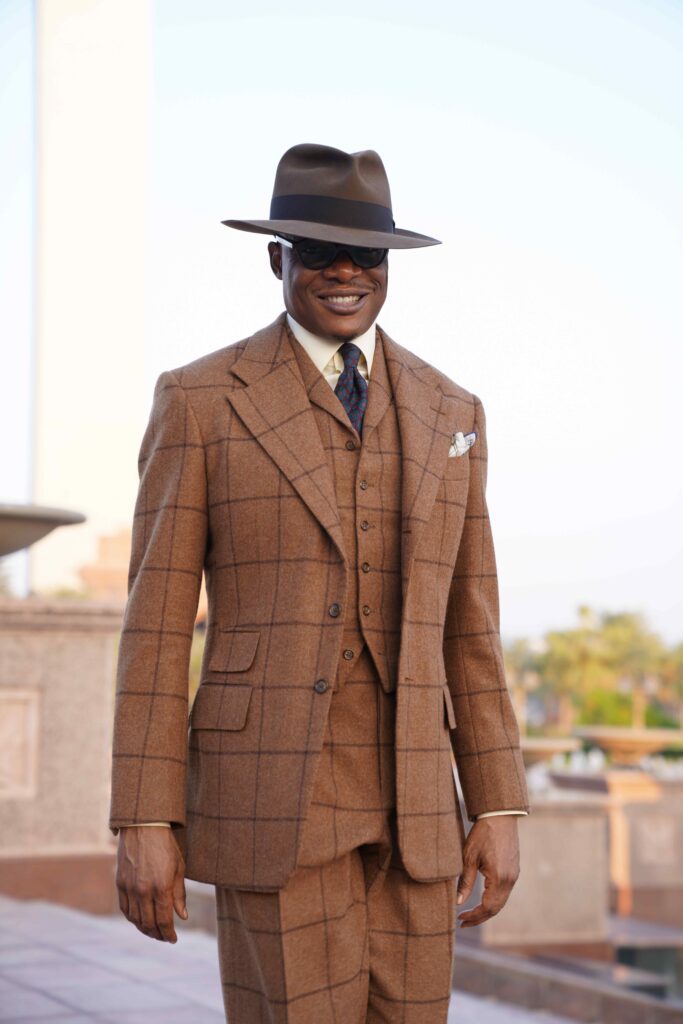Time for tweed?
As winter sets in for a few months’ residence in many parts of the world, our cold weather clothes are brought out and dusted off. Chances are that your jackets or possibly full suits, are made of tweed, that dependable stalwart of the winter wardrobe.

Long-associated with college professors, librarians, shooters of birds and farmers, tweed started life in the Scotts highlands, woven to make blankets and kilts for those who dwelt in the mists north of Hadrian’s wall. To get technical for a bit, it is a twill weave. In fact, the word “tweed” is a corruption of the Scotts Gaelic “tweel”, which means, unsurprisingly, “twill”. So tweed is Scotts twill. Though it is often rough and bristly to the touch, it can be woven as a smooth cloth.
For many years favoured by Scots who worked outdoors, tweed was given celebrity status by Prince Albert (later Edward VIII), who bought an estate in Scotland and started wearing the estate tweed (Balmoral).
Tweed’s virtues include its durability and the warmth it provides. Woven in different colours, it is often associated with tartan or plaid, but tweed cloth can just as easily be monochrome (though seldom black).

Tweed varieties
Tweed comes in many varieties. The most iconic is Harris tweed, still woven by hand in the Outer Hebrides of Scotland, and defined by the 1993 Harris Tweed Act. Often woven from natural, undyed fibres, Harris tweed is used for jackets, coats and sometimes bags. Though people usually think of Harris tweed as thick and blanket-like, it is produced in different weights. Colours vary, thought “earth tones” are common. You can’t go wrong with it for outerwear. It is virtually waterproof, very tough and will never be out of style.
Donegal tweed comes originally from Donegal, Ireland. What makes it different is the little slubs or flecks in the weave. It is often woven in a basket-weave style, and can be light or heavy weight. Unlike Harris tweed, which is a brand and a process, Donegal is a style, so not all Donegal tweed comes from Ireland and some Donegal on the market is very light weight and not exactly what you might expect of tweed.
For other common tweed patterns, we have herringbone and barleycorn as two of the most common. Herringbone is well known; barleycorn used to be a popular pattern but is not seen often these days. Both can be made in virtually any colour and weight, but for genuinely tweedy herringbone and barleycorn, you need at least 12 ounces per metre / yard. Overcheck twill is a common design, where a large check pattern is woven over the herringbone or plain base weave.
Saxony, Shetland and Cheviot tweed are all types of wool. Saxony comes from Germany, originally, and is soft and smooth because it is made of merino wool. Saxony is not a weave or a style, and can come in different patterns. Shetland is made from sheep on the Shetland islands, who have light, soft wool. Cheviot tweed comes from sheep that live in the Cheviot hills on the Scotts borders; these sheep have wool that is rough and heavy.
Thornproof, a two-ply weave, is virtually indestructible (hence the name), and is often produced in a salt-and-pepper design, like Donegal tweed.
Tweeds that aren’t
Not all twill is tweed. Many twills, woven in checks or tartans are called tweed but aren’t. They are, or can be good cloth, but they are not tweed, and usually do not have its great properties – water proof, warm and touch.
Tweed for suits?

Many among us are happy with tweed jackets, but hesitant about tweed suits, particularly those featuring bold checks. Unless you are a bookie, a check suit in thick fabric might be too conspicuous, and you might not have many opportunities to wear it. AskOkey carries several tweed fabrics in muted patterns on the website, but not all of them are right for suits. Saxony and Shetland tend to be too soft, and do not hold a crease well (so not the best choice for trousers). Likewise, most Harris tweed does not crease well, but Cheviot and thornproof do, though they are probably too warm for all but the coldest days.
If you seldom step outside during the winter, or do so only to go between bus, train, car or office, tweed is best reserved for jackets to be worn at the weekend. But, if your work environment permits, or you enjoy outdoor activities, a tweed suit is second to none. It will protect you from just about all the elements and will look good for decades.